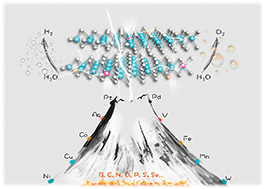当前位置:
X-MOL 学术
›
Chem. Soc. Rev.
›
论文详情
Our official English website, www.x-mol.net, welcomes your feedback! (Note: you will need to create a separate account there.)
TMD-based highly efficient electrocatalysts developed by combined computational and experimental approaches
Chemical Society Reviews ( IF 46.2 ) Pub Date : 2018-05-04 00:00:00 , DOI: 10.1039/c7cs00705a Changrong (Rose) Zhu 1, 2, 3 , Daqiang Gao 1, 2, 3, 4, 5 , Jun Ding 1, 2, 3 , Dongliang Chao 3, 6, 7 , John Wang 1, 2, 3
Chemical Society Reviews ( IF 46.2 ) Pub Date : 2018-05-04 00:00:00 , DOI: 10.1039/c7cs00705a Changrong (Rose) Zhu 1, 2, 3 , Daqiang Gao 1, 2, 3, 4, 5 , Jun Ding 1, 2, 3 , Dongliang Chao 3, 6, 7 , John Wang 1, 2, 3
Affiliation

|
As a large family of two-dimensional (2D) materials, transition metal dichalcogenides (TMDs) have been attracting an increasing level of attention and therefore considerable research input, owing to their intriguing catalytic, chemical and physical properties. The high exposed surface area, potentially large number of active sites, and chemical stability provide TMDs with vast opportunities for use as a unique class of electrocatalysts, while their low electrical conductivity and other deficiencies have drawn considerable research efforts for further modification. The optimization of TMDs can be achieved by several approaches, including site doping/modification, phase modulation, control of growth morphology and construction of heterostructures, by both appropriate computational simulations and purposely designed experimental studies. In tuning the TMD-based electrocatalysts, computational calculations have played uniquely important roles in predicting the structure and understanding the operational mechanism of catalytic performance. Indeed, the importance of refined calculations has been growing rapidly to provide comprehensive and unique guidance towards further modification of the existing TMD-based electrocatalysts and the discovery of new ones. In this critical review, we will look into the rapid advancement of the highly efficient TMD-based electrocatalysts that have been developed in recent years, achieved by combined computational and experimental approaches. Aiming to provide a generalized overall picture, we have conducted further computational studies as a systematic approach to unveil the modulation in the structure and the improvement in electrocatalytic properties brought in by appropriate element doping/modification in either basal plane A-(metal atoms) and B-(chalcogen atoms) sites or edge sites of the 2D TMD materials, as well as in some of those non-layered metal disulfides/diselenides. This review is concluded by summarizing the likely future development and perspectives of TMD-based electrocatalysts.
中文翻译:

通过计算和实验相结合的方法开发的基于TMD的高效电催化剂
作为二维(2D)材料的大家族,过渡金属二卤化物(TMD)由于其令人着迷的催化,化学和物理性质而受到越来越多的关注,因此也投入了大量的研究投入。高暴露的表面积,潜在的大量活性位点和化学稳定性为TMDs用作独特的一类电催化剂提供了广阔的机会,而它们的低电导率和其他缺陷吸引了相当多的研究工作以进行进一步的修饰。通过适当的计算模拟和专门设计的实验研究,可以通过几种方法来实现TMD的优化,包括位点掺杂/修饰,相调制,生长形态控制和异质结构的构建。在调整基于TMD的电催化剂时,计算计算在预测结构和理解催化性能的运行机理方面发挥了独特的重要作用。确实,精确计算的重要性已迅速增长,以提供全面,独特的指导,以进一步修改现有的基于TMD的电催化剂和发现新的电催化剂。在这篇重要的评论中,我们将研究近年来通过组合计算和实验方法实现的高效TMD基电催化剂的快速发展。旨在提供概括的总体情况,我们已经进行了进一步的计算研究,作为系统的方法来揭示结构的调节以及通过在基面A-(金属原子)和B-(硫族元素)原子中进行适当的元素掺杂/修饰而带来的电催化性能的改善。 2D TMD材料的边缘位置,以及某些非层状金属二硫化物/二硒化物中的边缘位置。通过总结基于TMD的电催化剂的可能的未来发展和前景来结束本综述。
更新日期:2018-05-04
中文翻译:

通过计算和实验相结合的方法开发的基于TMD的高效电催化剂
作为二维(2D)材料的大家族,过渡金属二卤化物(TMD)由于其令人着迷的催化,化学和物理性质而受到越来越多的关注,因此也投入了大量的研究投入。高暴露的表面积,潜在的大量活性位点和化学稳定性为TMDs用作独特的一类电催化剂提供了广阔的机会,而它们的低电导率和其他缺陷吸引了相当多的研究工作以进行进一步的修饰。通过适当的计算模拟和专门设计的实验研究,可以通过几种方法来实现TMD的优化,包括位点掺杂/修饰,相调制,生长形态控制和异质结构的构建。在调整基于TMD的电催化剂时,计算计算在预测结构和理解催化性能的运行机理方面发挥了独特的重要作用。确实,精确计算的重要性已迅速增长,以提供全面,独特的指导,以进一步修改现有的基于TMD的电催化剂和发现新的电催化剂。在这篇重要的评论中,我们将研究近年来通过组合计算和实验方法实现的高效TMD基电催化剂的快速发展。旨在提供概括的总体情况,我们已经进行了进一步的计算研究,作为系统的方法来揭示结构的调节以及通过在基面A-(金属原子)和B-(硫族元素)原子中进行适当的元素掺杂/修饰而带来的电催化性能的改善。 2D TMD材料的边缘位置,以及某些非层状金属二硫化物/二硒化物中的边缘位置。通过总结基于TMD的电催化剂的可能的未来发展和前景来结束本综述。



























 京公网安备 11010802027423号
京公网安备 11010802027423号